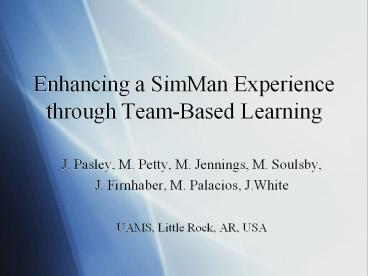Enhancing a SimMan Experience through Team-Based Learning - PowerPoint PPT Presentation
1 / 22
Title:
Enhancing a SimMan Experience through Team-Based Learning
Description:
Enhancing a SimMan Experience through Team-Based Learning J. Pasley, M. Petty, M. Jennings, M. Soulsby, J. Firnhaber, M. Palacios, J.White UAMS, Little Rock, AR, USA – PowerPoint PPT presentation
Number of Views:90
Avg rating:3.0/5.0
Title: Enhancing a SimMan Experience through Team-Based Learning
1
Enhancing a SimMan Experience through Team-Based
Learning
- J. Pasley, M. Petty, M. Jennings, M. Soulsby,
- J. Firnhaber, M. Palacios, J.White
- UAMS, Little Rock, AR, USA
2
Introduction
- Physiology educators formerly used animal-based
laboratory exercises to reinforce basic
physiological concepts. - Medical simulation is now used to provide a link
between basic science education and clinical
bedside teaching.
3
Introduction
- Patient simulation brings learning concepts to
life in a clinical setting.
4
Overview
- Implementation of Simulation in Physiology
- Cardiovascular
- Pulmonary
- Implementation of TBL to encourage Preparation
for SimMan Experience
5
The Process
Spring 2000 - 2002
Modification of Courses
Spring 2003 - 2005
Included TBL
Spring 2005
2007
Modified TBL Added 3 mannequins
6
Spring 2000-2002
- Standard use of ECG and Spirometer
- Cardiovascular Physiology
- ECG interpretation
- Myocardial blood flow
- Heart failure
- Respiratory Physiology
- Airway resistance
- Restrictive lung disease
- Obstructive lung disease
- Mediocre Examination Performance by Students in
both areas of Physiology
7
Spring 2003-2005
- Modified courses to include SimMan
- computer-driven patient simulator
- Groups of 10 students
- 20 minute experience
- Observations
- Students not well prepared prior to simulator
- Hands-on activity by 3-5 students
- Interested students, but still passive
8
Spring 2005
- Added TBL to encourage preparation
- First implementation in medical curriculum at
UAMS - Group size 10
- IRAT given as members arrive for Simulator in
waiting area - GRAT given just outside of Simulator
- Lively questioning by most students
- Faculty learned how lecture/questions needed
clarification - Application
- Next classroom session
- In conjunction with review session for test
- Problematic
9
Results
- Scores on the cardiovascular and respiratory
exams with SimMan experience increased
significantly compared to non SimMan experience.
10
Cardiovascular Physiology Cardiovascular Exams
correct
SEM 5.30
SEM 2.01
SEM 2.84
SEM 2.25
SEM 6.50
Pre SIM-MAN 2000 - 2002
2003
2004
2005
No SIM-MAN 2006
11
Respiratory Physiology Respiratory Questions
Correct
SEM 7.14
SEM 5.65
SEM 4.76
SEM 9.84
SEM 3.45
No SIM-MAN 2006
2004
2005
Pre SIM-MAN 2000 - 2002
2003
12
(No Transcript)
13
Modified TBL 2007
- Day before SimMan Experience
- IRAT- based on lecture concepts
- GRAT-group quiz and discussion over same
questions as IRAT - Application quiz administered during classroom
review of SimMan exercise
14
- More experience with TBL needed to demonstrate
improvement by TBL use - Critical to get all concerned faculty involved
- Need to Examine impact of TBL on Learning
Physiologic concepts using SimMan - Collect more data to determine whether TBL has an
impact on learning.
15
SIM-Man/TBL 2007
- Three mannequins allowed smaller group size (6)
and more time enhanced SIM-Man experience - Problems in test administration nullified our
ability to measure impact of TBL
Results
16
Conclusions
- Simulator encounters reinforce Basic Science
Concepts presented in Physiology Lectures - Simulator experience Significantly Impacted
Learning - TBL Enhanced student Preparation for the SIM-Man
experience
17
Future Plans
18
(No Transcript)
19
Rationale
- To shift focus from learning key concepts to
using concepts - To replace lecture format with a more hands on
experience - To encourage students to come prepared
20
Rationale
- Demonstrate cardiovascular and pulmonary
physiology concepts in a Medical Physiology
course using simulation.
- Examine student performance on exam questions in
cardiovascular and respiratory physiology before
and after the simulation experience.
21
Cardiovascular Physiology
Question Topic Pre SIM-MAN correct SIM-MAN correct NO SIM-MAN correct
ECG Interpretation 65 85 72
Cardiac Blood Flow 56 84 52
Ischemic Heart Disease/Heart Failure 60 82 48
22
Respiratory Physiology
Question Topic Pre SIM-MAN correct SIM-MAN correct NO SIM-MAN correct
Airway Resistance 56 90 51
Obstructive Lung Disease 53 82 70
Restrictive Lung Disease 50 72 54































